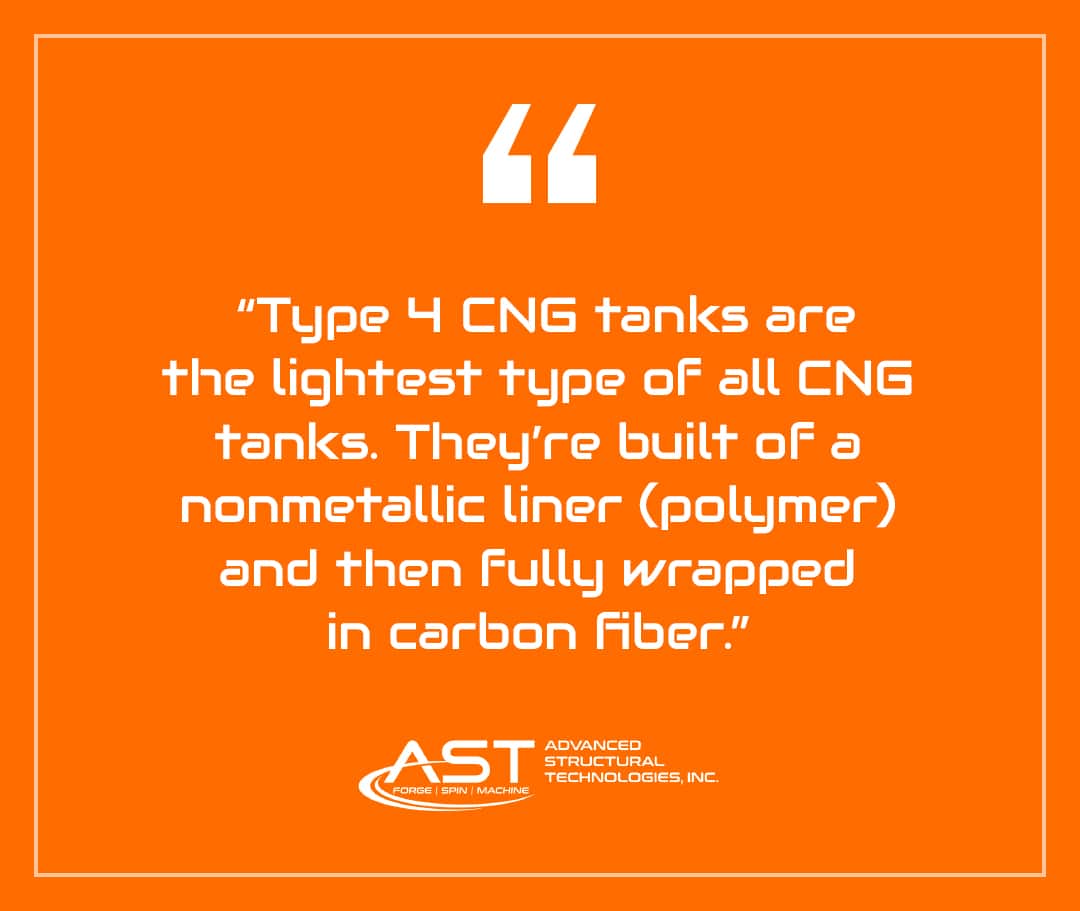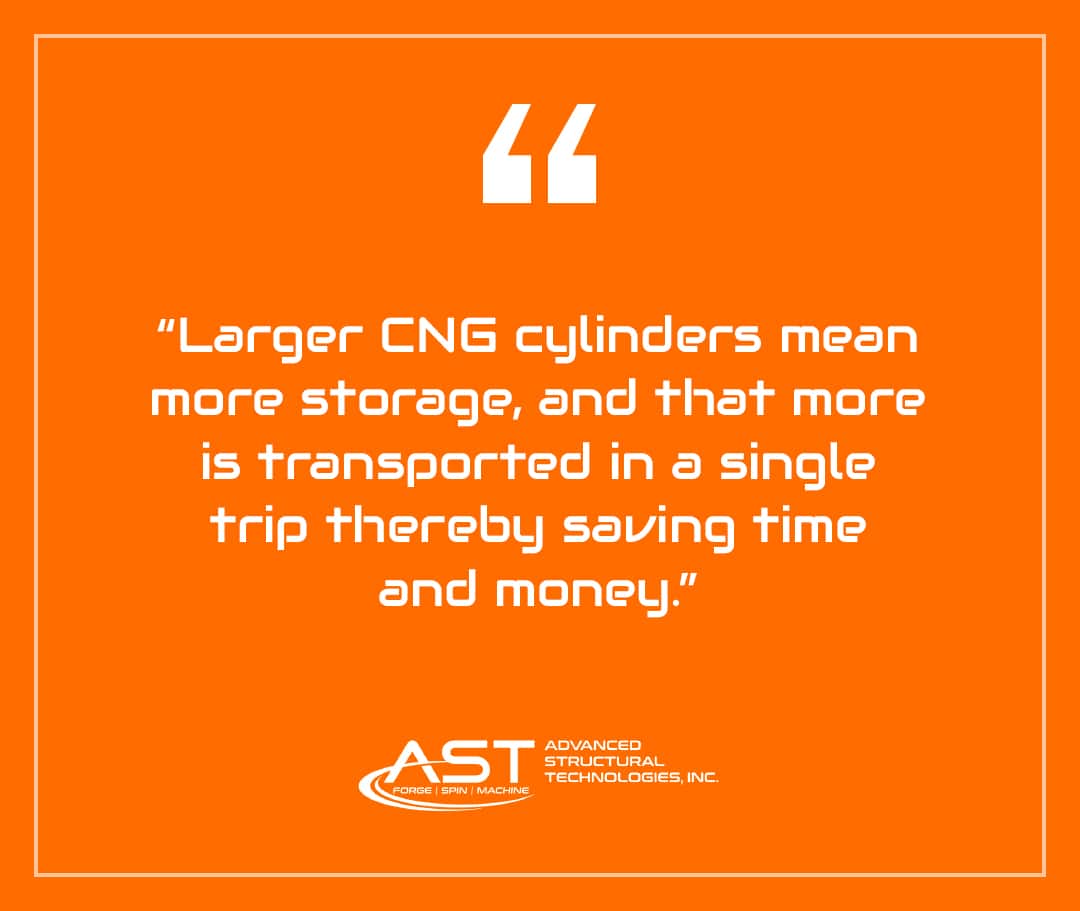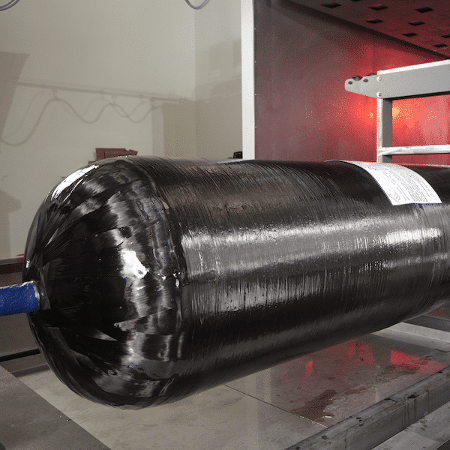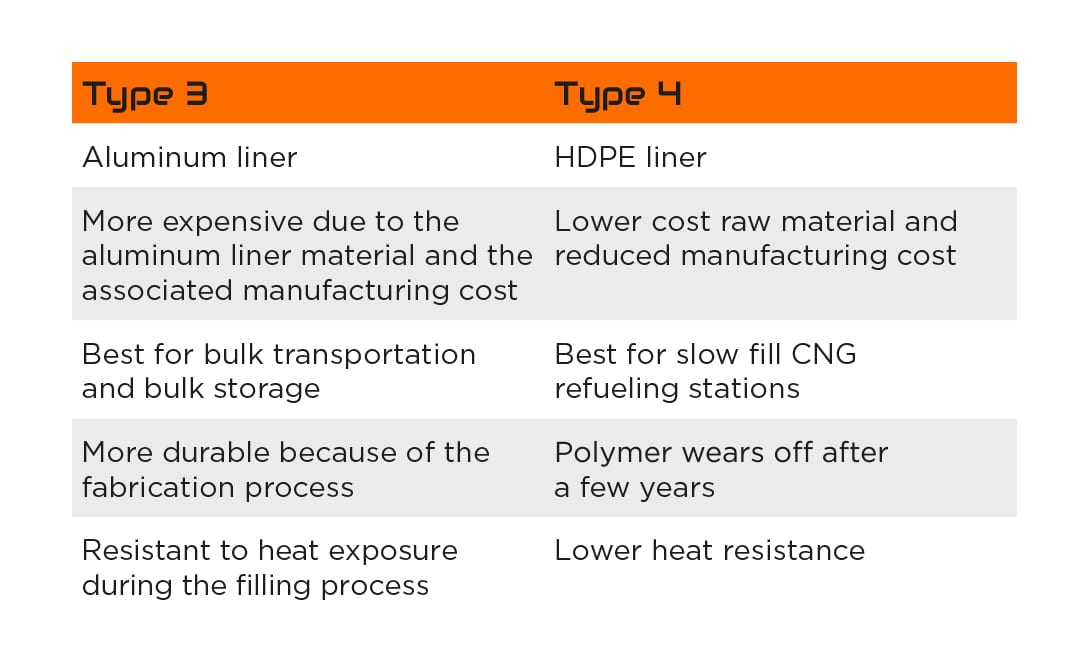Compressed Natural Gas CNG Storage Options [Ultimate Guide]

Reducing air pollution and mitigating over-dependence on imported fuel sources are the main reasons for the increase in demand for compressed natural gas (CNG).
Although CNG production is at an all-time high, a major obstacle confronting the widespread acceptance of CNG is that there are not enough pipelines to transport the valuable commodity.
As the need for alternative fuel sources grows, the demand for CNG transport and storage tanks is on the rise.
At Advanced Structural Technologies, we manufacture large diameter Type 3 storage and transport solutions for CNG and other alternative/renewable energy sources. Our high-capacity/high-pressure vessels come in a variety of liner designs to suit different customer applications.
In this guide, we’re going to explore the available CNG storage options in the market and their suitable applications. This should empower you in choosing the appropriate alternative energy storage solution for your firm’s needs.
Here’s what we’ll cover:
What Is Compressed Natural Gas, or CNG?
Compressed natural gas (CNG) is an eco-friendly fuel that’s made by compressing methane (natural gas) to 1% of its normal volume.
Natural gas is a fossil fuel that occurs naturally when heat and pressure come into contact with organic materials. CNG should not be confused with LNG, which is natural gas in its liquid form.
CNG stored under high pressure occupies less volume, which makes it easier for transportation and storage for later use in industrial, residential, and vehicular applications.
Compressed natural gas produces CO2 and water vapor when it burns. It reduces carbon monoxide emissions by over 95%. This is why it’s considered the cleanest of all fossil fuels.
CNG is locally available in the USA. It’s also cheaper than coal and gasoline. Due to this, CNG usage as an alternative fuel is on the rise.
Compressed Natural Gas Applications
The Energy Policy of 1992 classifies CNG as an alternative fuel source to limit carbon emissions. The policy seeks to improve air quality through alternative fuels, renewable energy, and energy efficiency.
At present, CNG contributes to 30% of all the energy consumed in the United States.
40% of the total CNG goes into producing electricity. 30% goes into residential use (i.e., heating and cooking). The remaining 30% goes into industrial use.
The usage of CNG is expected to rise in the coming years due to the call to limit pollutants. Other fuel sources (e.g., petroleum and coal) are harmful to the environment and pollute the air, causing health problems.
By embracing CNG, the USA can tremendously limit its dependence on imported fuels. Natural gas is locally available in North America, which makes it a cheaper fuel source.
Compressed Natural Gas can also be enriched with hydrogen (HCNG). This is a developing, zero-emissions and clean energy market, whose adoption is driven by climate change initiatives, urban air quality levels, and the need for strategic energy independence.

Hydrogen is better suited to high-uptime, heavy transport, and remote power applications due to its advantageous refuel times and system weight (when compared to batteries).
How Is Natural Gas Transported?
After extraction from the wells, hydrogen and natural gases are treated and transported to distributors through pipelines. The distributor then transports the gas to customers in pressurized CNG tanks also known as CNG cylinders.
One reason limiting the use of CNG as a fuel source is the lack of enough pipelines to transport the gas to consumers, many of whom are off the grid from the major pipelines.
The use of virtual pipelines is considered safer for the environment. Clearing of extensive forest cover to accommodate the size of the pipelines has been detrimental to animal and tree species, especially in Pennsylvania where most CNG is mined.
Virtual/mobile pipelines involve the transportation of CNG through the road in high-pressure vessels to customers who need CNG storage on site.
For example:
- CNG refueling stations for fleets — These are dedicated sites by organizations that own several heavy-duty vehicles. They use CNG as a primary source of fuel, and vehicles go there to refuel.
- Mining companies — Operation of heavy-duty mining equipment using CNG helps in saving costs. Most mining companies will have onsite storage for CNG.
- Marine vessels — This involves the use of CNG as a fuel source to run ships and boats. It also involves the transportation of CNG by sea to consumers in remote areas.
- Backup power systems — A catalyst breaks up HCNG into protons and electrons. The electrons then create a flow of electricity therefore hydrogen is needed to fuel the generator.
Different methods are utilized for on-site storage. For example, HCNG is stored with further infrastructure that can compress it to the expected bar pressure.
To optimize refueling frequency, these large users of CNG need lightweight tanks to enable easy transportation for the smooth operation of their high horsepower equipment.
Natural Gas Storage Options
Compressed natural gas (CNG) is stored and transported in thick-walled pressurized tanks. These tanks are built in a long cylindrical shape with semi-spherical edges. The shape provides for the equal distribution of stresses from the pressure of the gas.

CNG tanks are made of steel, aluminum, or composite materials. There are four types of storage tanks based on the material, namely:
- Type 1
- Type 2
- Type 3
- Type 4
Buyers must understand the applicability of each type and how it suits their needs and usage.
Type 1 CNG Storage Overview
Type 1 CNG storage tanks are made of solid steel. They were the first CNG storage options available and were first introduced during the early 1900s.
The steel walls of Type 1 CNG storage tanks are approx. 0.5 to 1.5 inches thick, making them the heaviest type of CNG storage tanks.
A standard Type 1 cylinder has a diameter of 11 inches for the smallest and 16 inches for the largest.
Type 1 cylinders have a history of reliability and durability. They can accommodate heat, sun, and scratches without getting damaged.
The Type 1 design is widely used in the industry due to its low initial cost. It’s also a very standard design that can be accommodated in various configurations.
Type 1 CNG storage tanks are suitable for:
- Bulk transportation — Since Type 1 tanks are the thickest, they are safe for transportation of CNG in instances where low weight is not a requirement.
- Stationary ground storage — Type 1 has the ability to handle varying pressures, making it ideal for permanent storage at CNG fueling stations and industries where CNG is needed on-site (e.g., for heating or to operate machinery).
The Type 1 CNG storage tank is very heavy because it’s entirely made of steel. In environments where vehicle weight is an issue, Type 1 is not appropriate for the transport of compressed natural gas in large quantities.
Type 1 has also been known to crack if its maximum tensile strength is not maintained correctly. This issue can be prevented by making sure that the tank does not exceed the maximum load required.
Using high-quality, high-strength vessels is a good way to avoid problems like cracking or bursting. The use of lighter tanks will also allow transportation of CNG in bulk, eliminating the risk of the need to exceed the load.
Type 2 CNG Tank Overview
Type 2 CNG tanks are also known as hoop-wrapped because of the composite fiber wound around the cylindrical sections.
The core of a Type 2 cylinder is built of a steel liner that’s then wrapped in either of the following composite materials:
- fiberglass
- carbon fiber
- wire
The metallic parts of the cylinder give the storage pressure while the wrap gives a safety factor.
Type 2 CNG tanks are light compared to Type 1. However, they are still much heavier than Type 3 and Type 4 vessels.
Type 2 cylinders are suitable for:
- High-pressure medical oxygen storage — In a healthcare setting, these vessels are suitable due to their low cost and pressure needed.
- Vehicular application — Personal vehicles that use CNG are growing popular, and Type 2 cylinders are mostly applied here.
Type 2 tanks are very vulnerable to corrosion, acids, and cuts, and abrasions to the wrap. They’re also prone to damage by UV light. They must be well-covered to keep them safe from breakage.
Type 3 CNG Tank Overview
Type 3 CNG storage cylinders are not only strong but also lighter weight. They are built of an aluminum liner that is fully wrapped with carbon fiber. The carbon fiber is wound onto the aluminum liner in alternating winding patterns (helical, high- and low-angle helical and hoop) is to provide a safety factor and more strength.

Type 3 vessels can hold very high pressures. A standard Type 3 cylinder can hold a service pressure of 3,600 psi. At AST, Inc, our Type 3 cylinders can accommodate service pressures of 3,600–7,500 psi.
The aluminum liner allows these cylinders to hold more volume than other tanks of the same dimensions. Type 3 vessels have the highest manufacturing costs due to their complexity and the various raw materials required to make their liner.
If you think of how much more you can get in a Type 3 tank, the cost is worth it in the long run.
When space is a factor to consider, a Type 3 is significantly better than Type 1 and Type 2 because it can hold more volume and weighs less. They reduce the cost of transportation by 50% and help save money on transport and storage expenses.
Type 3 tanks are suitable for:
- Transportation of CNG in bulk– Because of the lightweight factor in Type 3 cylinders, they’re the best for bulk transportation of CNG. They can transport larger volumes in a few trips as compared to all other tank types.
- On-site storage of CNG– Type 3 cylinders will not burst up until 20,000 psi. This makes them suitable for onsite storage for industries that need CNG on the site. They’re also suitable for dedicated refueling stations for fleets.
Due to the thin metallic wall around the vessel’s cylindrical region, this design feature can cause cyclic fatigue. This is, however, very unlikely, since the certified service pressure is lower than 20,000 psi, which is the maximum burst pressure.
Type 4 CNG Tank Overview
Type 4 CNG tanks are the lightest type of all CNG tanks. They’re built of a nonmetallic liner (polymer) and then fully wrapped in carbon fiber.

Due to the HDPE (high density poly ethylene) liner, Type 4 tanks are lighter than Type 3, which are made with an aluminum liner. The versatility of the Type 4 vessel has allowed it to be utilized for:
- On-site storage tank applications — At CNG refueling stations for fleets, Type 4 tanks are a suitable choice due to their ability to dispense gas continuously.
- Transportation of compressed natural gas — Due to being very lightweight, Type 4 cylinders are good for transportation of CNG in bulk.
A Type 4 CNG tank is the least prone to cyclic fatigue. It is, however, vulnerable to hot temperatures and is not safe when exposed to heat from sunlight for extended periods.
Type 3 vs Type 4 CNG Storage Tanks
Type 3 and Type 4 vessels are fully wrapped composite vessels that are used for transporting compressed natural gas (CNG). While they can be commonly found in various applications, they have some key differences when it comes to their intended use.
CNG Storage Tank Diameters
A standard Type 3 tank is 20–26 inches in diameter.
Advanced Structural Technologies manufactures CNG tanks of up to 26 inches in diameter. They are high pressure and high capacity, making them suitable for both storage and transport solutions for CNG.
CNG Storage Tank Capacity
The capacity of a CNG is expressed below in a gasoline gallon equivalent range.
How to Choose the Right CNG Storage Option
Choosing the right CNG storage option is essential for every application. When deciding which type is appropriate for the intended purpose, consider the following.
- Safety — CNG transportation and storage can lead to a health hazard if the gas leaks. Always ensure the cylinders are stored well and protected from scratches and extreme heat.
- Intended application — Different types of CNG tanks are appropriate for different applications. Use the right one that fits the purpose and the environment.
- Government regulations — All CNG cylinder production must comply with government certifications. Follow the stipulated regulations for the country you are operating in to avoid problems.
- Budget — Type 3 cylinders are the safest, but also the most expensive. It is recommended to choose Type 3 cylinders whenever cost is secondary to reliability and durability of cylinders in the field.
Large CNG Tanks
Larger CNG cylinders mean more storage, and that more is transported in a single trip thereby saving time and money.

At AST, Inc, we construct the largest tanks in diameter available today. These tanks can withstand stresses of up to 10,000 psi.
Transport More Gas
The world needs cleaner, cleaner and greener fuels and alternative energy sources. Compressed Natural Gas is a good alternative to help fill the demand. It is available domestically and diffuses into the air easily without emitting harmful compounds.
Contact us for sales and inquiries. We are happy to discuss how we can help you solve your CNG and other alternative energy storage issues.







